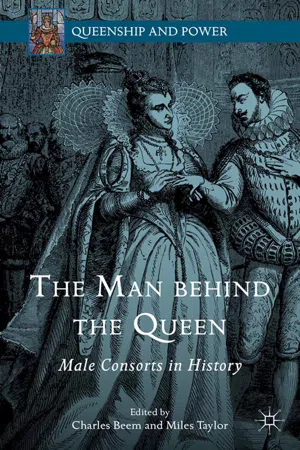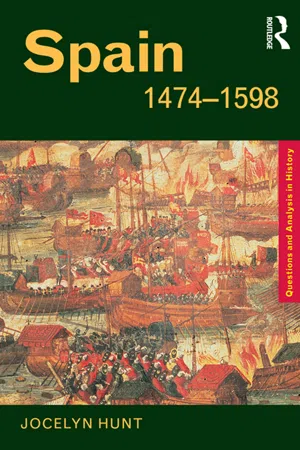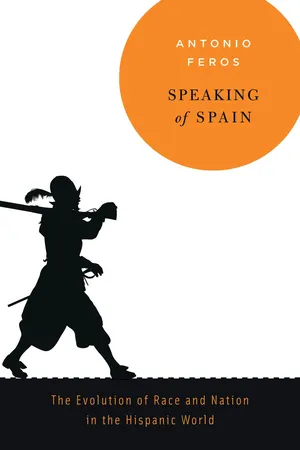History
Ferdinand II of Aragon
Ferdinand II of Aragon, also known as Ferdinand the Catholic, was a significant figure in the history of Spain. He played a key role in the unification of Spain by marrying Isabella I of Castile and initiating the Spanish Inquisition. Under his rule, the Reconquista was completed, and the foundations for the Spanish Empire were laid.
Written by Perlego with AI-assistance
Related key terms
6 Key excerpts on "Ferdinand II of Aragon"
- eBook - ePub
The Man behind the Queen
Male Consorts in History
- C. Beem, M. Taylor, C. Beem, M. Taylor(Authors)
- 2014(Publication Date)
- Palgrave Macmillan(Publisher)
without Isabella. First, I attempt to ascribe certain specific initiatives to Ferdinand rather than Isabella. Second, I attempt to show that the interests of Ferdinand as king of Aragon have been underestimated during the lifetime of Isabella, greatly affecting our understanding (or misunderstanding) of the direction the policy of the Catholic Monarchs took. The emphasis in the approach I adopt is thus policy rather than personality, though this was an age in which personality often determined policy. If at times I appear to be talking more about the “Aragonese” direction of policy than about Ferdinand himself, this is because I obstinately insist that the hand of Ferdinand can be detected in the wider direction of policy, which in my view was geared more to the interests of Ferdinand in Aragon and its dependencies than has generally been assumed. Clearly it is not possible here to examine all aspects of the many reigns of Ferdinand, and it has seemed best to make a ruthless selection of linked topics, connected to the treatment of religious minorities in Spain and further afield. This way we see Ferdinand at work in not just Aragon, Valencia, and Catalonia, but Sicily, Sardinia, and Naples, and exercising strong influence in both Portugal and Navarre, as well as in the newly discovered islands of the Caribbean. It is also an aspect of the reigns of Ferdinand and Isabella that has dominated discussion of the period in recent years.This geographical range is itself unusual, for another feature of the books by Ladero, Edwards and Liss is their emphasis on the affairs specifically of Spain, more especially Castile. This reflects, once again, traditional preoccupations. It is the legacy of a long-standing centralist view of Spanish history that maintained its dominance under Franco. As well as an emphasis on the formation of a Spanish state, we find an emphasis in some works on the Christian identity of that state, reaffirmed when the Catholic Monarchs dealt harshly, though rather differently, with their Jewish and Muslim subjects. In the years around 1940, the idea of the Christian mission of Castile was forcefully expressed in the works of José-Maria Doussinagué on the foreign policies of Ferdinand the Catholic, one of the few works on the reign which concentrates heavily on the early sixteenth century. The learned Carlist historian of law and political ideas, Elías de Tejada, saw the Spanish occupation of the kingdom of Naples as beneficial to southern Italy precisely because it drew the area into the unique world of Christian Spanish civilisation, which was, he passionately argued, neither European nor African. The views of these historians might easily be dismissed as irrelevant and outdated, were it not for the fact that Elías de Tejada still has his enthusiasts in contemporary Naples, where one of his books has recently appeared in Italian (admittedly under the imprint of a far Right publishing house), and that Doussinagué and his contemporaries exposed to view a rich documentation which makes their works essential places of reference.9 - eBook - ePub
- William Maltby(Author)
- 2008(Publication Date)
- Bloomsbury Academic(Publisher)
The marriage of Isabella of Castile and Ferdinand of Aragon on October 18, 1469, began the unification of the Spanish kingdoms and created the nucleus of a much larger empire. Both countries had by this time suffered from decades of intermittent civil war. Isabella, supported by most of the Castilian nobility, succeeded her half-brother Enrique IV in 1474. In an effort to prevent her accession, a faction associated with the late king allied themselves with Portugal, and launched a bloody but unsuccessful war that ended only in 1479. In that year the death of Ferdinand’s father made him King of Aragon. Aragon and Castile were now linked by marriage, but the union of the two crowns was—and would remain—personal. By the terms of their marriage agreement, Ferdinand ruled Aragon but had only limited rights in Castile; Isabella as ruler of Castile would have even fewer in Aragon and its dependencies. After each died, their common heir would become ruler of Spain, but he or she would inherit the two kingdoms separately (plus Sicily), and each kingdom would retain its own government, institutions, and privileges.The arrangement could have been a recipe for disaster. The young rulers differed in interests and personality, and their marriage, in private at least, was not entirely tranquil. Ferdinand, a model for Machiavelli’s Prince , was cynical and devious but a capable soldier and a master of diplomacy. The deeply religious Isabella was more interested in domestic policy and had the surer grasp of what would today be called public relations. Both, however, were pragmatists at heart. While Isabella lived, the royal couple pursued a common policy.By necessity, that policy was expansionist. Ferdinand and Isabella are correctly regarded as the founders of modern Spain, but they knew nothing of the modern concept of nationhood and did not consciously set out to create either a nation or an empire. Instead, like other rulers of the day, they based their policies on dynastic interest modified at times by religious considerations. Their first priority was to strengthen royal authority in Castile, now badly eroded by decades of strife and misrule. The situation in Aragon was equally bad, but Ferdinand believed that the kingdom’s long-established fueros precluded serious reform. Castilian institutions seemed more amenable to change. Even there, however, Isabella lacked the resources or the inclination to impose her authority by force. She needed the cooperation of nobles and town governments, and knew that this required incentives. At the Cortes of Toledo in 1480 Isabella confirmed the nobles in their possession of lands taken illegally before 1466 on condition that they return those taken thereafter. Throughout her reign, she granted mayorazgos that allowed them to entail portions of their estates, thereby avoiding the trap of partible inheritance which diluted the wealth of their families. Mayorazgos were an important favor, as were mercedes - eBook - ePub
- Jocelyn Hunt(Author)
- 2015(Publication Date)
- Routledge(Publisher)
Aragon, far more than Castile, was involved in Mediterranean trade, and her island possessions encouraged this. But Ferdinand would not have gone to war in Italy merely to extend his trading opportunities, or to procure grain, had he not had other motives. He had, for example, a modern and professional army, which had been tested in Granada. Among the innovations made by Ferdinand and his military commander de Córdoba were a small force of arquebusiers (hand gunners) and a substantial number of lightly armed and highly trained pikemen. The preferred method of attack, as applied in Granada, Italy and subsequently in the Pyrenees, began with an intense artillery bombardment to breach defensive walls or emplacements. Then the pikemen and crossbowmen would lead the assault, with the arquebusiers in support, almost as snipers, to pick off the enemy leaders. The small troops of cavalry would then chase and harry the retreat. In Italy, this army confronted and fought alongside the hired mercenaries of both France and the Italian states. Ferdinand was able to demonstrate that a genuine ‘national’ army could hold its own with the condottiere who earned their livings by selling their military skills. Status and glory were bound to result from successful campaigns against the might of France. The main reason for Ferdinand’s involvement in Italy was, however, a determination to reduce or at least limit the power of France. The rivalry between Aragon and France was long lived, although France had tended to side with Castile in conflicts against Portugal and its English allies. Throughout his reign, Ferdinand engaged in a series of alliances whose central aim was to weaken and intimidate France. The marriage alliances, while seldom directly linked to conflict with France, had the effect of reducing the opportunities for the French royal family to forge similar links - eBook - ePub
- Antonio Feros(Author)
- 2017(Publication Date)
- Harvard University Press(Publisher)
1Spains
IN OCTOBER 1469, two young princelings—Isabel, eighteen, and her cousin Ferdinand, seventeen—married in a small Castilian town in virtual secrecy. As members of the same Trastámara dynasty, their marriage was an attempt to establish order and stability in the peninsula following decades of conflict, regicides, rebellions, and civil wars.Isabel became queen of the crown of Castile in 1474 when she succeeded her brother Enrique IV. Five years later, in 1479, Ferdinand became king of the crown of Aragon. This was strictly a union of heads, not bodies: the marriage accords did not call for, or envisage, a true political and juridical union of the two crowns and their kingdoms. Nevertheless, the practical result of the marriage was that for the first time in centuries, the two most powerful states in the Iberian Peninsula were dynastically amalgamated.Many nineteenth- and twentieth-century historians claimed that this fateful union of the crowns of Aragon and Castile stitched together a territorial unit rent asunder by the eighth-century Arab invasion of the peninsula and also unquestionably marked the birth of Spain as a nation and state. In the past few decades, however—at least since the establishment of democracy in Spain in the 1970s—historians have challenged this interpretation. In their view, the marriage of Ferdinand and Isabel did not forge a nation, and the old kingdoms survived as autonomous entities with deeply entrenched “national” identities that have endured until the present day. Alternatively, a growing number of early modern historians have observed that one of the key if unintended consequences of the marriage between Isabel and Ferdinand was not the creation of a nation-state so much as the emergence of a well-defined Spanish national identity. They find evidence of this process in cultural and juridical concepts and practices that reveal an increasingly widespread sense among early modern Spaniards of belonging to a “Spanish” nation and in a growing popular tendency to self-identify unambiguously as “Spaniards.”1 - eBook - ePub
- J. Edwards(Author)
- 2014(Publication Date)
- Routledge(Publisher)
Although the notion of the king (or queen) as having two ‘bodies’, one personal and one institutional, had by the fifteenth century been generally accepted, at least in the monarchies of England, France and Spain, there was certainly no ‘statute of limitations’ in the Trastamaran monarchies of Castile and Aragon, to restrict the functions of governmental institutions. Instead, these offices and ‘departments’ might readily be adapted to new activities, as fresh demands faced the sovereigns and the often spectacular incidents of Isabella and Ferdinand’s reigns were amply to demonstrate this point, even if resulting governmental problems were to be bequeathed to the Habsburgs. Crown of Castile It has often been observed that, despite their somewhat dubious reputation as ‘new monarchs’ who supposedly moved towards a ‘modern’ absolutist system of government, Ferdinand and Isabella in fact established very few new governmental and administrative institutions in their respective kingdoms. This was certainly so in Castile, where their main achievement was to use more effectively the institutions that existed in the reigns of John II and Henry IV. The effects of past political instability were still evident up to Isabella’s death and even more obvious thereafter (see Chapter 7). Nevertheless, Castile provided the main base for Isabella and Ferdinand’s political activity, both in Europe and further afield. One reason for this, apart from the demographic preponderance of Castile over the Crown of Aragon, was the former’s strong ‘imperial’ tradition of monarchy, which dated back to the time of Alfonso X, in the mid- to late thirteenth century. As will be seen, Aragonese and Catalan institutions were largely decentralized and much more open to scrutiny, and in some cases control, by other groups, such as the nobility and the burgesses of the major cities, especially Barcelona and Valencia - eBook - ePub
- Francisco García Fitz, João Gouveia Monteiro, Francisco García Fitz, João Gouveia Monteiro(Authors)
- 2018(Publication Date)
- Routledge(Publisher)
4 Crown of Aragon Mario Lafuente Gómez I Early and High Middle Ages Feudal conquest and colonization (10th to 13th centuries) Political outline On the eve of the year 1000, the peninsular territories between the Pyrenean Cordillera, the Iberian System and the Mediterranean Sea housed a complex network of political structures, poorly integrated with each other and very heterogeneous in social, economic and cultural terms. Three hundred years later, however, these territories were organized into three great spaces of sovereignty, placed under the authority of three feudal monarchies and internally very coherent. These three areas were the Crown of Castile, the kingdom of Navarre and the Crown of Aragon, which included practically the entire southern fringe of the Pyrenees, most of the Ebro valley, the south-eastern half of the Iberian Cordillera and a large part of the Mediterranean coast. In total, approximately 103,000 km 2 divided, unequally, into three different states: Aragon, which occupied about 48,000 km 2 ; Catalonia, with approximately 32,000 km 2 ; and Valencia, the dimensions of which exceeded 23,000 km 2. Moreover, at the end of the 13th century, the kingdom of Majorca was also linked to the dynasty that ruled the Crown of Aragon, because it had been an Aragonese monarch, Jaime I, who had conquered it in a war fought against the Almohad Empire (1229). Nevertheless, in his will, Jaime I decided that the kingdom of Majorca was to be separated from the rest of the peninsular possessions and yielded to a different heir than the one that was going to receive the rest of the Crown
Index pages curate the most relevant extracts from our library of academic textbooks. They’ve been created using an in-house natural language model (NLM), each adding context and meaning to key research topics.





